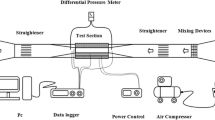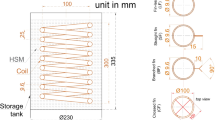Abstract
A numerical study has been conducted on thermal dissipation fin shape of the magnetron of a microwave oven. The main focus of the study was on reducing the bypass away from cooling air around cooling fins and enhancing the heat transfer around cylindrical anode body with numerical investigation on louver, slit, dimple and bending shape. To optimize the location and the shape of the elliptical dimple, RSM(DOE) was adopted to enhance the thermal dissipation from the cylindrical anode of magnetron. The flow separation around the anode was delayed due to optimized dimple numerically and verified by experimental study. The enhancement of the fin cooling was utilized for cost reduction of the cooling fin by reducing the thickness of the fin from 0.6 mm to 0.5 mm, resulting in weight saving by 16.7 %.
Similar content being viewed by others

References
M. A. Sattorov, A. Bera, A. Sharma, W. J. Kang, O. J. Kwon, S. S. Jung, D. H. Kim, K. W. Lee, J. H. Won, C. H. Kook and G. S. Park, Thermal analysis of a strapped magnetron, IEEE Transactions on Electron Devices, 58 (8) (2011) 2784–2788.
H. K. Dwivedi and D. S. Venkateswarlu, Thermal design considerations for fast warm-up cathodes in MM wave magnetrons, IEEE Transactions on Electron Devices, 43 (11) (1996) 2011–2018.
P. V. Siva Rao, P. Srikrishna, N. K. Sharma and S. Subra-manian, Thermal analysis of magnetron injection gun, IEEE International Vacuum Electronics Conference (2009) 491–492.
K. S. Bhat, K. Sreedevi and M. Ravi, Thermal analysis of electron gun for travelling wave tubes, Applied Surface Science, 253 (2) (2006) 679–682.
R. Crivello and R. W. Grow, Thermal analysis of PPM-focused rod-supported TWT helix structures, IEEE Transactions on Electron Devices, 35 (10) (1988) 1701–1720.
W. Jiang, J. Wang, Y. Luo, L. Xu, X. Yao and S. Wang, Thermal analysis of sheet beam gun for the sheet beam traveling wave tube, IEEE Transactions on Electron Devices, 63 (3) (2016) 1312–1316.
V. Gahlaut, R. K. Sharma and V. Srivastava, Thermal and structural analysis of electron gun for high efficiency space TWT, International Conference on Emerging Trends in Electronic and Photonic Devices & Systems (2009) 409–412.
X. Li, X. Shang, X. Su, W. Liu, L. Xiao and S. Yu, Thermal design of high efficiency, high reliability pulsed space TWT’s grid-controlled electron gun, IEEE Transactions on Electron Devices, 62 (5) (2015) 1648–1654.
R. Sawicki, Analytical determination of the thermal/mechanical performance of traveling wave tube electron guns, Electron Devices Meeting, 24 (1978) 160–163.
Y. Han, Y. Liu, Y. Ding, P. Liu and C. Lu, Thermal analysis of a helix TWT slow-wave structure, IEEE Transactions on Electron Devices, 55 (5) (2008) 1269–1272.
D. S. Venkateswarlu and A. Sil, Imperfect boundaries: thermal response of the cathode surface of a potted heater-cathode assembly, Applied Surface Science, 52 (1) (1991) 7–17.
J. Gong, C. Min, C. Qi, E. Wang and L. Tian, Numerical simulation of flow and heat transfer characteristics in wavy fin-and-tube heat exchanger with combined longitudinal vortex generators, Int. Comm. Heat Mass Transfer, 43 (2013) 53–56.
J. Y. Jang and J. Y. Yang, Experimental and 3-D numerical analysis of the thermal-hydraulic characteristics of elliptic finned-tubes heat exchangers, Heat Transfer Engineering, 19 (4) (1998) 55–67.
F. P. Incropera and D. P. Dewitt, Fundamentals of Heat and Mass Transfer, 5th Ed., Wiley, New York, USA (2002).
Author information
Authors and Affiliations
Corresponding author
Additional information
Recommended by Associate Editor Chang Yong Park
Dong Ho Park is currently a Senior Engineer at Samsung Electronics. He received M.S. in Mechanical Engineering from Sogang University, Korea. His research interests are computational fluid dynamics, heat transfer and fluid dynamics.
Eung Ryeol Seo, Ph.D., is currently a Master at Samsung Electronics in Korea. He received his Ph.D. in Mechanical Engineering from Texas Tech University in 2001. His main research area is CFD-based fan/duct design for home appliances.
Myoung Keun Kwon is currently a Principal Engineer at Samsung Electronics. He received Ph.D. in Mechanical Engineering from Sungkyunkwan University, Korea in 2008. His research interests are in rarefied gas dynamics, vacuum technology and home appliances.
Chang Seon Lee is currently a Vice President at Samsung Electronics in Korea. He received an M.S. in Mechanical Engineering from Korea University in 1993. His research interests are in fan design, refrigeration cycle and heat transfer.
Rights and permissions
About this article
Cite this article
Park, D.H., Seo, E.R., Kwon, M.K. et al. A study on thermal fluid flow of magnetron cooling for microwave oven. J Mech Sci Technol 33, 1915–1923 (2019). https://doi.org/10.1007/s12206-019-0342-x
Received:
Revised:
Accepted:
Published:
Issue Date:
DOI: https://doi.org/10.1007/s12206-019-0342-x



